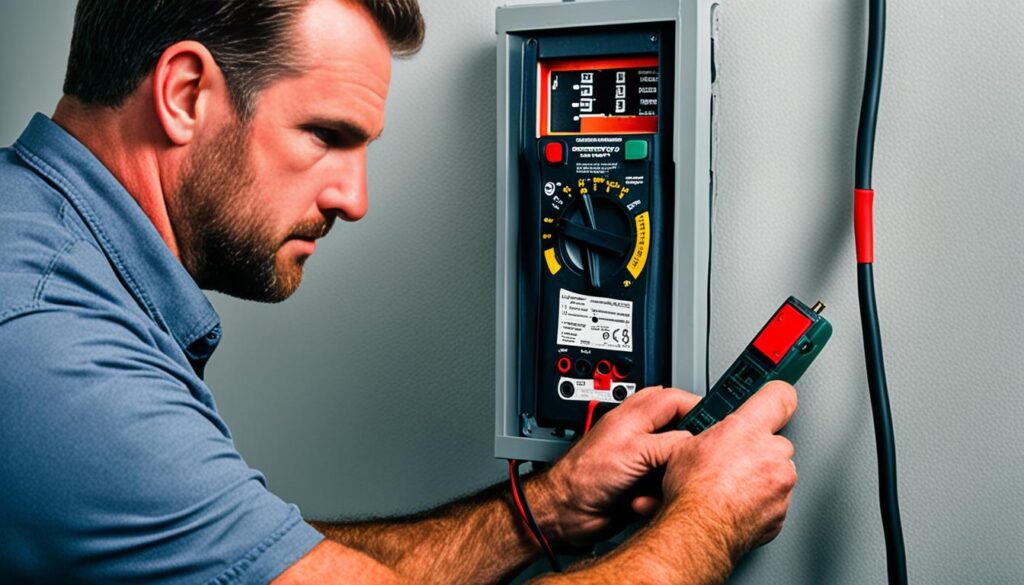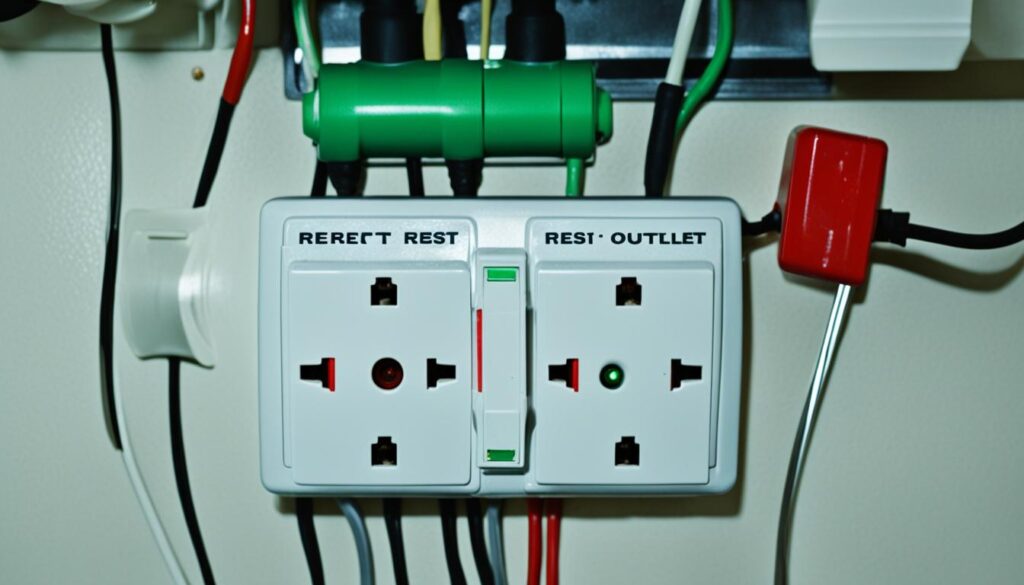Dealing with kitchen outlets not working can be frustrating. When your electrical outlets malfunction, it can disrupt your daily routines and create inconvenience in your kitchen. However, with the right troubleshooting steps, you can identify and resolve the issues effectively, ensuring that your kitchen outlets are functioning optimally once again.
There are several potential causes for kitchen outlets not working. It could be a tripped GFCI outlet, a blown fuse, a faulty device, a burnt-out outlet, or a tripped circuit breaker. To fix the problem, it’s important to understand the anatomy of outlets and follow proper troubleshooting procedures.
In this article, I will guide you through the process of troubleshooting your kitchen outlets, helping you identify the root cause of the problem and offering suggestions on how to resolve it. While some issues can be fixed by homeowners, remember that complex electrical systems may require the expertise of a professional electrician to ensure safety and prevent further damage.
Key Takeaways:
- Diagnose the problem by checking for a tripped GFCI outlet, a blown fuse, a faulty device, a burnt-out outlet, or a tripped circuit breaker.
- Understand the anatomy of outlets to effectively troubleshoot the issue.
- Safely reset a tripped GFCI outlet and replace blown fuses to restore power to the outlets.
- Replace burnt-out outlets to prevent potential hazards.
- Check the circuit breaker panel for tripped breakers and address overloading or short circuits as necessary.
Half-Hot Outlet and Device Issues
When it comes to kitchen electrical issues, non-working outlets can be a frustrating problem to deal with. One particular issue that can cause confusion is a half-hot outlet, also known as a lamp outlet. In this setup, only one part of the outlet is controlled by a wall switch. If you’re experiencing problems with this type of outlet, there are a few troubleshooting tips you can try before seeking professional help.
To begin, it’s important to check if there is a switch that controls the outlet. Sometimes, the switch may have been accidentally turned off, causing the outlet to appear non-functioning. If the switch is turned on and the outlet still doesn’t work, it’s time to rule out faulty devices or appliances.
One way to determine if the issue lies with the outlet or the device/appliance is by plugging in different devices into the outlet. If none of them work, it indicates that the problem is with the outlet itself. However, if some devices work while others don’t, then the issue may be specific to those malfunctioning devices.
If the problem persists even after testing different devices, it may indicate a larger electrical issue that needs professional attention. In this case, it’s best to consult with a licensed electrician who can diagnose and fix the problem safely and efficiently.

Remember, safety should always be a priority when dealing with electrical issues. If you are unsure or uncomfortable working with electricity, it’s always best to leave it to the experts.
GFCI Outlet and Fuse Problems
When it comes to kitchen outlet maintenance and repair, two common issues that homeowners may encounter are GFCI outlet problems and blown fuses. Understanding how to troubleshoot and address these issues can help ensure that your kitchen outlets are functioning properly.
GFCI Outlets
GFCI outlets, or ground fault circuit interrupter outlets, play a crucial role in protecting against electrical shock. These outlets are designed to detect imbalances in electrical current and quickly shut off the power to prevent accidents. If your kitchen outlets are not working, one possible cause could be a tripped GFCI outlet.
Resetting a tripped GFCI outlet is a simple and straightforward process. Locate the GFCI outlet, which is typically installed near sinks or in areas with a higher risk of water exposure. Press the “reset” button on the outlet to restore power to the connected outlets. This step often resolves the issue and restores functionality.
If the outlet keeps tripping or won’t reset, it may indicate water infiltration or damage. In such cases, it is important to wait for the outlet to dry out or replace the GFCI outlet.
Blown Fuses
In some cases, kitchen outlets may stop working due to blown fuses. Fuses act as protective devices that interrupt the electrical flow when they detect excessive current. When a fuse blows, it needs to be replaced to restore power to the outlets.
To check for blown fuses, locate your fuse box or electrical panel. Inspect the fuses and look for any that have a broken filament or appear blackened. These are signs of a blown fuse. Carefully remove the blown fuse and replace it with a new one of the same amperage rating.
Checking the fuse box and replacing blown fuses can often resolve the issue and restore power to your kitchen outlets.
By addressing GFCI outlet problems and blown fuses, you can effectively maintain and repair your kitchen outlets. Remember to always prioritize safety and consult a professional electrician if you are unsure of how to handle any electrical issues.

Continue reading to learn more about common issues with kitchen outlets and how to troubleshoot and repair them.
Burnt-Out Outlets and Tripped Circuit Breakers
If you notice outlet problems in your kitchen such as outlets not working, it is crucial to address them promptly to ensure safety and avoid potential hazards. Burnt-out outlets are a serious concern and should be replaced immediately. Signs of a burnt-out outlet include scorch marks or a burning smell. If you encounter these signs and have ruled out other potential issues, replacing the outlet is the recommended solution for kitchen outlet repair.
Kitchen outlets can also lose power due to tripped circuit breakers. Circuit breakers act as a safety mechanism to protect your electrical system from overloading and short circuits. When a circuit is overloaded or a short circuit occurs, the circuit breaker trips and cuts off the power to the affected outlets.
Here’s a step-by-step guide for troubleshooting tripped circuit breakers:
- Locate your circuit breaker panel. It is typically found in the basement, utility closet, or garage.
- Open the panel door and look for any circuit breakers that have tripped. A tripped breaker is usually in between the “ON” and “OFF” position or slightly towards the center.
- To reset a tripped circuit breaker, firmly push the handle to the “OFF” position and then back to the “ON” position.
If the circuit breaker trips immediately upon resetting or if you experience recurring tripped breakers, it may indicate a more serious electrical problem. In such cases, it is highly recommended to consult a licensed electrician for further investigation and repair.
Remember, outlet problems in the kitchen can pose safety risks, and it’s crucial to address them promptly. Replace burnt-out outlets and properly reset tripped circuit breakers to ensure the efficient and safe functioning of your kitchen’s electrical system.

Conclusion
Troubleshooting kitchen outlets not working requires careful diagnosis and proper steps to resolve the issue. As homeowners, we often encounter electrical problems in our kitchens that can disrupt our daily routines. From a tripped GFCI outlet to a blown fuse, there are various potential causes behind non-working kitchen outlets. However, it is important to remember that not all issues can be resolved on our own. Seeking professional help for complex electrical systems is highly recommended to ensure safety and prevent further damage.
Regular maintenance and prompt repair of kitchen outlets are essential to keep our kitchens functional and safe. By understanding the potential causes and following the troubleshooting tips discussed in this article, we can take proactive measures to address issues with our kitchen outlets. Remember to always prioritize safety and seek professional assistance when needed.
So, whether it’s replacing a burnt-out outlet or resetting a tripped circuit breaker, taking action and resolving kitchen outlet problems will not only bring convenience back to our kitchen space but also provide peace of mind knowing that our electrical system is in good working condition. Don’t let non-working kitchen outlets disrupt your day-to-day activities – take charge and fix the issue promptly.

